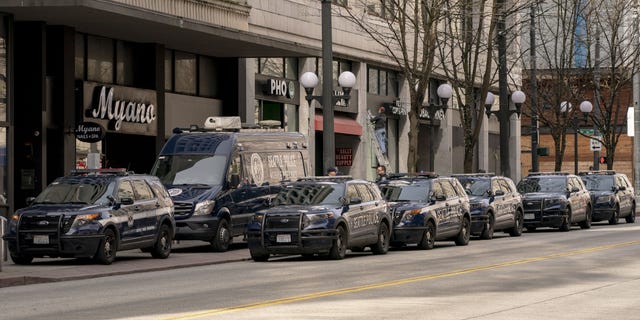A new report from the Department of Transportation (DOT) found traffic accidents and related deaths remain high compared to pre-pandemic times, and some experts blame a lack of policing.
A report from the DOT’s National Highway Traffic Safety Administration indicated that while deaths due to traffic incidents have dropped from 2021 to 2022, the rate is still higher than it was in the pre-pandemic era, with an 18% increase over 2019.
The rate of deaths in the first quarter of 2022 increased compared to the same period in 2021, rising about 7% overall, but the general rate year over year by December 2022 had gone down, with increases mainly in rural areas.
Rural interstate roadway incidents rose by about 12% while most other categories saw slight declines across the board, including out-of-state travel, vehicle rollover crashes and speeding-related crashes.
SAN FRANCISCO SURVEILLANCE VIDEO ILLUSTRATES AGONY OF CITY CRIME IN BOB LEE’S FINAL MOMENTS
A Chicago traffic jam. (Patrick Gorski/NurPhoto via Getty Images)
There were also increases in motorcyclist fatalities, which rose 5%; pedestrian fatalities, which rose 2%; and cyclist fatalities, which rose 8%. Crashes involving at least one large truck rose 10%.
The still-elevated numbers may have resulted from a decrease in police traffic enforcement, one expert told NPR.
Jonathan Adkins, CEO of the Governors Highway Association (GHSA) blamed a reduction in policing that followed the George Floyd protests of 2020.
NYC SUSPECT ARRESTED IN CONNECTION TO SHOOTING OF NYPD OFFICER

Jonathan Adkins, executive director of the Governors Highway Safety Association, speaks during a National Governors Association policy event in Washington, D.C., Feb. 6, 2018. (Zach Gibson/Bloomberg via Getty Images)
“Why do many of us drive dangerously on the roads? Because we think we can get away with it. And guess what — we probably can right now in many places in the country,” Adkins argued. “There’s not enforcement out there. They’re hesitant to write tickets. And we’re seeing the results of that.
“In a lot of places, we’ve shifted from one extreme to the other … where there may have been cases of over-policing, where we know people who are Black and brown have been disproportionately stopped,” he added. “But perhaps we’ve gone too far on that other side.”
The GHSA tracks information on state highway safety laws and penalties and then determines federal funding for safety programs.
MARYLAND LAWMAKERS APPROVE GIVING AG POWER TO BRING CRIMINAL CHARGES AGAINST COPS

Seattle Police Department vehicles surround a mobile precinct unit on Third Avenue in downtown Seattle March 24, 2022. (David Ryder/Bloomberg via Getty Images)
Data from the Seattle Municipal Courts showed that traffic infractions had dropped some 86% compared to 2019.
Seattle Police Chief Adrian Diaz said the department lost hundreds of officers after 2020, and that resulted in a decrease of dedicated traffic details. And patrol officers now spend the significant bulk of their shift responding to more urgent calls.
“Some of the officers don’t feel like they have enough adequate time to do the traffic enforcement,” Diaz told NPR.
CLICK HERE TO GET THE FOX NEWS APP
Another possible cause, the report notes, may relate to the fear of deadly encounters over minor violations, such as the death of Daunte Wright in Minnesota in 2021.
“There was a feeling that, if there was a way to reduce these violations, that you would reduce potential disparities and stops, and you would also eliminate unnecessary contacts,” Diaz said.